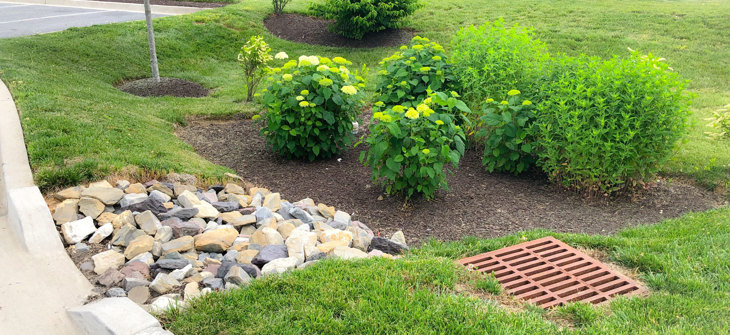
Techniques for Maximizing Runoff Reduction with Biofiltration
The terms “high-rate biofiltration” and “runoff reduction” aren’t often used in the same sentence. The engineering community has a preconceived notion that a high-rate biofilter with an underdrain (like Filterra®) can’t provide runoff reduction benefits because the stormwater it treats moves through the practice too quickly. However, with the proper design considerations, we can maximize the capability of a high-rate biofilter to provide appreciable runoff reduction.
Runoff reduction defined
While it might seem rudimentary to define runoff reduction, looking at a concept in its simplest form often sheds light on how we can reasonably tackle problems. As precipitation falls on impervious surfaces (roads, parking lots, etc.), the water that flows over these surfaces is called runoff. Sending large volumes of runoff to streams, rivers, and lakes causes problems with erosion, pollution, and flooding. To decrease this volume, the runoff must be prevented from reaching the bodies of water we want to protect. This can be achieved by reducing runoff production by using pervious surfaces or by delaying/ preventing its release into the receiving waters. Runoff reduction occurs when we prevent the runoff from entering the receiving waters. This is commonly done by infiltration, evapotranspiration, or reuse of the runoff.
In a high-rate biofilter, we can reduce runoff by encouraging infiltration and evapotranspiration. Infiltration occurs when the stormwater in the biofilter soaks into the surrounding soils. Evapotranspiration is generally a much smaller volume than infiltration, but the evaporation of water from the soils and the uptake and transpiration by plants shouldn’t be ignored.
Design techniques for maximizing runoff reduction
Since infiltration is the most effective way to maximize runoff reduction, we should prioritize the water’s access to the in situ soils. Using our Bioscape configuration of Filterra would be one way to do this – the Filterra Bioscape is installed without the concrete containment structure, allowing water to move into the surrounding soils from all sides of the media bed, thereby maximizing the infiltrative surface area.
Infiltration doesn’t happen just because we want it to. Well-draining soils with high saturated conductivity (Ksat) rates are critical to maximizing infiltration and runoff reduction. If multiple soil types are available on a project, locating the biofilter in soils with high Ksat will help ensure that treated stormwater infiltrates the soils rather than exiting through the underdrain. Another critical consideration for choosing the location of a biofilter is the proximity to groundwater. The closer the groundwater elevation is to the bottom of the biofilter, the more saturated the surrounding soils will be, limiting the opportunity for infiltration (never mind the possible regulatory limitations on infiltrating near groundwater).
Water can move through high-rate biofilters quickly, which isn’t a surprise given the nomenclature. Providing additional storage within the practice can help increase the residence time of treated stormwater and encourage additional infiltration. The easiest (and relatively affordable) place to increase storage in a Filterra Bioscape is in the underdrain stone. Typically, it is 6” in depth, but increasing the total stone depth to 12” or 18” creates additional storage below the underdrain, from which water can only leave the practice by infiltration.

The final consideration is selecting plants with dense, fibrous root zones. In the Great Lakes region, where I’m located, I’ve seen native grasses perform this function very well. Not only are they hardy enough to survive the winter, but the root zones grow very quickly and reach depths far in excess of other, more ornamental plants. Fibrous root zones provide hydraulic pathways throughout the media to help water infiltrate the surrounding soils. Additionally, deeper and denser root systems can take up more water and transpire more, further reducing the system’s runoff.
How much runoff reduction are we talking about?
The question you may be left with, then, is how much runoff reduction can a high-rate biofilter provide? As mentioned previously, that will all depend on the site characteristics where the biofilter would be installed. Factors that limit infiltrative capacity will have the greatest negative impact on the reduction of runoff by biofiltration. We are currently examining a Filterra Bioscape field installation designed with these techniques and considerations in mind. Stay tuned, as we may soon be able to share a technical report with our findings!
